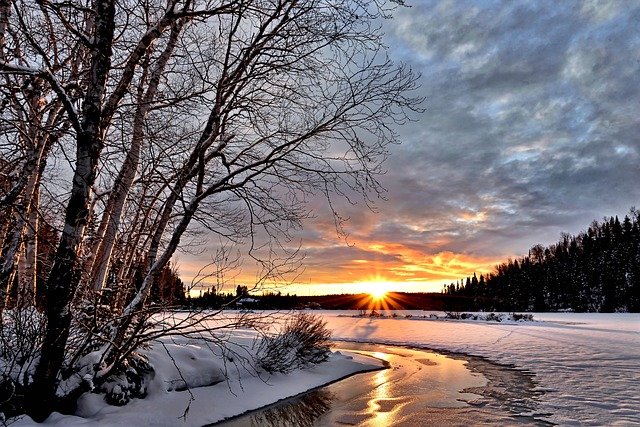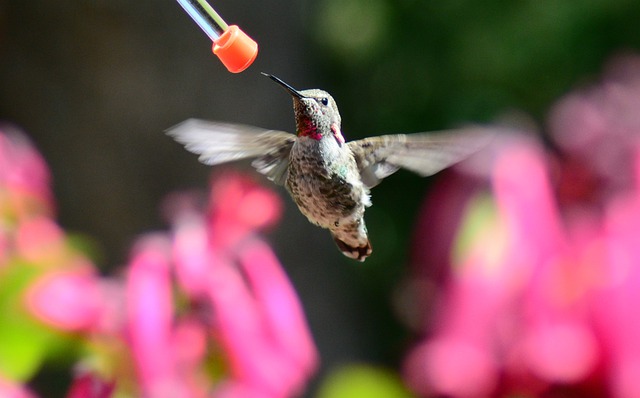No, Anna’s Hummingbirds do not migrate, they tend to stay within the region they’re located, whether it be the Alaskan coast, Northern Mexico or California and it’s where you’d see the majority of Anna’s all year round.
Although Anna’s hummingbirds don’t migrate like other hummingbirds within America, they still commit to migration in their own way. This is by seeking higher or lower altitudes based on the weather where in the summer they stay at the upper bay area of California whilst winter has them chilling in the lowlands of Cali.
Where Do Anna’s Hummingbirds Migrate To In The Winter?
Due to the developing horticulture (the art of garden cultivation) within the regions Anna’s stay. Unlike other hummers Anna’s have found that they can live year round in places like California and Mexico as there’s plenty of food to go around from the flowers that still bloom and the feeders we continue to leave out for them.
Now the only thing an Anna’s hummingbird does is migrate in altitude as opposed to flying hundreds to thousands of miles over the sates or other countries i.e. Canada and Mexico.
In Los Angeles California these tiny pink necked birds stay in the lowlands of California when it’s winter whilst migrating to the bay area in summer, which technically is located at a much higher altitude. Horticulture has expanded into other regions too such as British Colombia, Canada so the same altitude based migration is followed there as well.
How Do Anna’s Hummingbirds Survive Winter As They Don’t Migrate?

It’s often believed the reason hummingbirds migrate is as a result of dipping temperatures however, the reality is it’s mostly due to less daylight and lower food supplies. Horticulture to some degree means food supplies won’t decrease as drastically within California as they do in the regions other hummers often stay.
Therefore, Anna’s Hummingbirds simply need to keep themselves warm and get through winter instead of migrating all the way north or south multiple times a year.
How they do this is by stocking up on food, gaining 15 – 20 percent extra body after which they go into a state of torpor
whilst sleeping. Anna’s will use these energy reserves to keep themselves warm during a cold winters night.
The torpor state essentially slows down the metabolism of the Anna’s putting themselves in a somewhat hibernation state where energy consumption is reduced significantly. Consequently, this allows Anna’s hummingbirds to effectively get through the winter months.
What Do Anna’s Hummingbirds Eat In The Winter?
Anna’s hummingbirds tend to eat smaller insects, they take advantage of the feeders laid out by others as well as the flowers and shrubs located within their respective regions.
Their diet doesn’t change all too much from the warmer months however, as food supply is lower they generally will consume less food and again the torpor state further minimises energy consumption resulting in the metabolic rate of these hummers slowing down too.
Food supply isn’t extremely terrible otherwise most Anna’s would be migrating to warmer climates every year nevertheless, horticulture won’t completely make up for the loss in food which is why the consumption needs to decrease so an Anna’s hummingbird can effectively make it through winter.
How To Care For An Anna’s Hummingbird Through Winter?

If you want to support the Anna’s hummingbirds in the winter months, there are a few things you can do. First of you can support by providing a food supply through feeders. 4 parts water and 1 part sugar should do the trick and make sure to keep the mixture natural, away from any artificial colouring particularly red dye.
Secondly, you’d want to keep an eye on the mixture as much as you can so it doesn’t freeze. There are 2 things you can do here to stop the nectar from freezing.
- Regularly rotate feeders.
- Purchase a heat source to make sure the mixture remains liquid. You can cause a light source that emits heat something similar like a heated bottle to accomplish this.
Another way you can help Anna’s is providing them with the option of a hot bath. Leave some hot water out near the feeders and they might just take a dip.
There are a variety of other ways to assist Anna’s overwinter too such as placing dome like covers over the feeder to minimise the icing or slating of the sugar mixture, positioning the feeders so cold winds won’t affect it as often.
Lastly, if you want to help more than one Anna’s hummingbird, having multiple feeders would be worth doing as hummingbirds are territorial over food and well, you probably wouldn’t want a whole bunch of hummers battling it out in your backyard through your typical winters day.
Summary
Anna’s have no need to migrate south as a result of flowers, shrubs among other forms of vegetation remaining present within Los Angeles or British Colombia all year round. As a result there’s no need to move, instead they simply migrate in altitude to lessen the heat or cold.
Food supply isn’t scarce as plenty of feeders are scattered about and the ability to enter the tropor state easily makes sure the intense metabolism of Anna’s won’t result in them starving by winters end.
Everything put together negates the need for migration as ultimately it’d be a waste a time when all they need is literally where the Anna’s already stay.
References
https://www.birdnote.org/listen/shows/annas-hummingbirds-winter-north
https://hummingbirdmarket.com/pages/feeding-hummingbirds-in-cold-weather
https://www.google.com/amp/s/blog.education.nationalgeographic.org/2017/01/11/how-do-hummingbirds-survive-the-winter-what-does-this-have-to-do-with-a-mission-to-mars/amp/
Amhil Khan, a dedicated nature enthusiast and the founder of BirdsOfTheWild.com, is a passionate advocate for the captivating world of avian wonders. With a deep-seated curiosity about the intricate lives of birds, Amhil’s journey began as a fascination and has evolved into a mission to inspire others to appreciate and protect these magnificent creatures.
Amhil’s love for birds led to the creation of Birds of the Wild, a platform where his expertise in ornithology, coupled with his captivating storytelling, provides readers with an immersive and educational experience. Through his lens and words, he captures the essence of birds in their natural habitats, offering a glimpse into their behaviors, migrations, and the ecosystems they inhabit.

